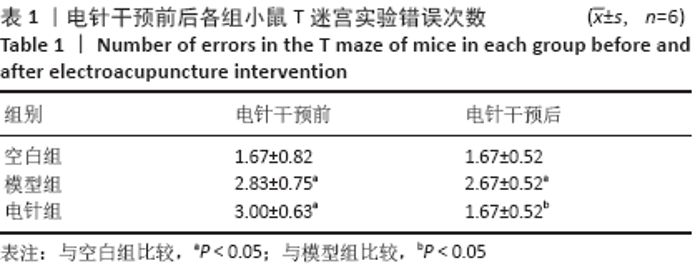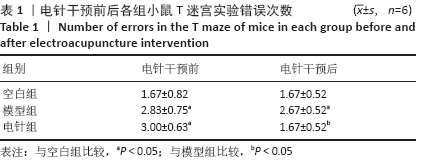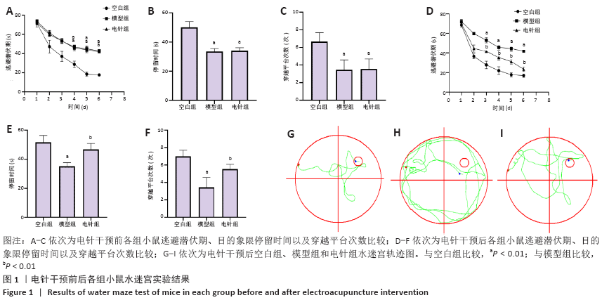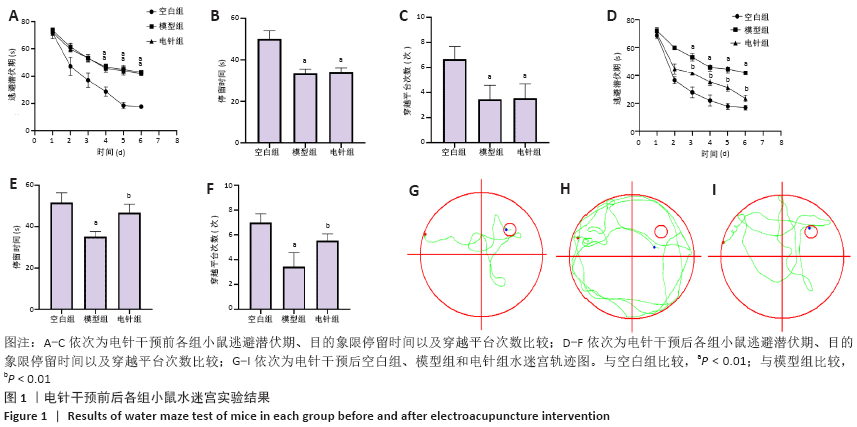[1] LIEVENS Y, GOSPODAROWICZ M, GROVER S, et al. Global impact of radiotherapy in oncology: Saving one million lives by 2035. Radiother Oncol. 2017;125(2):175-177.
[2] 朱小娟,姜东耀,东贵荣.放射性脑病案[J].中国针灸,2020,40(6): 678.
[3] HOPEWELL JW, TROTT KR. Volume effects in radiobiology as applied to radiotherapy. Radiother Oncol. 2000;56(3):283-288.
[4] DAVIS CM, ROMA PG, ARMOUR E, et al. Effects of X-ray radiation on complex visual discrimination learning and social recognition memory in rats. PLoS One. 2014;9(8):e104393.
[5] 高剑峰,郑婉君,吕明惠,等.电针干预对放射线照射小鼠海马神经元凋亡的影响及机制研究[J].中华放射肿瘤学杂志,2017,26(12): 1443-1448.
[6] 杨光,裴亚妮,邵淑君,等.电针“百会”“涌泉”对APP/PS1双转基因小鼠海马突触可塑性相关蛋白表达的影响[J].针刺研究, 2020,45(4):310-314.
[7] ZHAO J, SUI M, LÜ X, et al. Electroacupuncture promotes neural stem cell proliferation and neurogenesis in the dentate gyrus of rats following stroke via upregulation of Notch1 expression. Mol Med Rep. 2015;12(5):6911-6917.
[8] WANG Y, CHAN SL, MIELE L, et al. Involvement of Notch signaling in hippocampal synaptic plasticity. Proc Natl Acad Sci U S A. 2004;101(25): 9458-9462.
[9] 武鑫,孙宁宁,王冬慧,等.电针干预对放射线照射小鼠海马区突触蛋白-1表达的影响[J].上海针灸杂志,2020,39(6):783-789.
[10] 余曙光,郭义.实验针灸学[M].上海:上海科学技术出版社,2009: 149-150.
[11] 邵莹,罗占收.中医“治未病”思想与现代医学“预防、诊断和治疗”早期阿尔茨海默病[J].中国老年学杂志,2019,39(4):991-996.
[12] 夏昆鹏,逄静,李书霖,等.督脉电针对阿尔茨海默病患者学习记忆能力及血清APP、Aβ(1–42)的影响[J].中国针灸,2020,40(4): 375-378.
[13] 张涛,徐福如,蒋文君,等.电针肾俞穴对肾阳虚豚鼠形态行为及血清激素的影响[J].中国中西医结合杂志,2020,40(6):703-707.
[14] 郑丹妮,刘悦,刘通.基于数据挖掘的针刺治疗中风后抑郁的选穴规律分析[J].广州中医药大学学报,2020,37(7):1403-1409.
[15] 高媛媛,王旭,任路. “肾脑相济”电针对阿尔茨海默病模型小鼠行为学及IL-1b、TNF-α表达的影响[J].上海针灸杂志,2020,39(3): 359-364.
[16] FAN XW, LIU HH, WANG HB, et al. Electroacupuncture Improves Cognitive Function and Hippocampal Neurogenesis after Brain Irradiation. Radiat Res. 2017;187(6):672-681.
[17] 杨玉洁,李玉姣,李杉杉,等.用于评价大小鼠学习记忆能力的迷宫实验方法比较[J].中国比较医学杂志,2018,28(12):129-134.
[18] BREUNIG JJ, SILBEREIS J, VACCARINO FM, et al. Notch regulates cell fate and dendrite morphology of newborn neurons in the postnatal dentate gyrus. Proc Natl Acad Sci U S A. 2007;104(51):20558-20563.
[19] Koyanagi I, Akers KG, Vergara P, et al. Memory consolidation during sleep and adult hippocampal neurogenesis. Neural Regen Res. 2019; 14(1):20-23.
[20] HO DM, ARTAVANIS-TSAKONAS S. The Notch-Mediated Proliferation Circuitry. Curr Top Dev Biol. 2016;116:17-33.
[21] ROESE-KOERNER B, STAPPERT L, BRÜSTLE O. Notch/Hes signaling and miR-9 engage in complex feedback interactions controlling neural progenitor cell proliferation and differentiation. Neurogenesis (Austin). 2017;4(1):e1313647.
[22] SHA R, HAN X, ZHENG C, et al. The Effects of Electroacupuncture in a Rat Model of Cerebral Ischemia-Reperfusion Injury Following Middle Cerebral Artery Occlusion Involves MicroRNA-223 and the PTEN Signaling Pathway. Med Sci Monit. 2019;25:10077-10088.
[23] 雷蕾,孙宁,杜巧荣,等. Notch信号通路在神经精神领域的研究进展[J].中华临床医师杂志(电子版),2015,9(5):838-842.
[24] OHTSUKA T, SAKAMOTO M, GUILLEMOT F, et al. Roles of the basic helix-loop-helix genes Hes1 and Hes5 in expansion of neural stem cells of the developing brain. J Biol Chem. 2001;276(32):30467-30474.
[25] 武鑫,孙宁宁,吕明惠,等.不同疗程电针干预对放射线照射小鼠海马神经干细胞增殖分化的影响[J]. 针刺研究,2019,44(11): 787-792,816.
[26] ERIKSSON PS, PERFILIEVA E, BJÖRK-ERIKSSON T, et al. Neurogenesis in the adult human hippocampus. Nat Med. 1998;4(11):1313-1317.
[27] BRAI E, MARATHE S, ASTORI S, et al. Notch1 Regulates Hippocampal Plasticity Through Interaction with the Reelin Pathway, Glutamatergic Transmission and CREB Signaling. Front Cell Neurosci. 2015;9:447.
[28] ALBERI L, LIU S, WANG Y, et al. Activity-induced Notch signaling in neurons requires Arc/Arg3.1 and is essential for synaptic plasticity in hippocampal networks. Neuron. 2011;69(3):437-444.
[29] RAUTI R, CELLOT G, D’ANDREA P, et al. BDNF impact on synaptic dynamics: extra or intracellular long-term release differently regulates cultured hippocampal synapses. Mol Brain. 2020;13(1):43.
[30] LEAL G, COMPRIDO D, DUARTE CB. BDNF-induced local protein synthesis and synaptic plasticity. Neuropharmacology. 2014;76 Pt C: 639-656.
[31] SASI M, VIGNOLI B, CANOSSA M, et al. Neurobiology of local and intercellular BDNF signaling. Pflugers Arch. 2017;469(5-6):593-610.
[32] 何丽玲,龙清华,胡慧,等.大补元煎通过上调BDNF/TrkB/CREB信号通路改善APP/PS1双转基因痴呆小鼠海马突触可塑性[J].中国实验方剂学杂志, 2020(网络首发)
[33] 郏丹赟,李芝慧,张民远,等.电针对急性束缚性应激大鼠海马组织BDNF/TrkB表达的影响[J].中国中西医结合杂志,2018,38(7): 865-869.
[34] 李秘,李凯,丁宁,等.电针对创伤后应激障碍大鼠杏仁核及海马区环磷腺苷效应元件结合蛋白的表达及与突触蛋白结合能力的影响[J].针刺研究,2020,45(7):517-523.
[35] 周鹏佑,蒲博轩,刘洋,等.生命早期PM(2.5)暴露对大鼠海马突触可塑性及Wnt/β-连环蛋白通路的影响[J]. 卫生研究,2020,49(3): 473-479.
[36] ZHU X, WANG P, LIU H, et al. Changes and Significance of SYP and GAP-43 Expression in the Hippocampus of CIH Rats. Int J Med Sci. 2019; 16(3):394-402.
[37] KOLOS YA, GRIGORIYEV IP, KORZHEVSKYI DE. A synaptic marker synaptophysin. Morfologiia. 2015;147(1):78-82.
[38] KWON SE, CHAPMAN ER. Synaptophysin regulates the kinetics of synaptic vesicle endocytosis in central neurons. Neuron. 2011;70(5): 847-854.
[39] GOOZEE KG, SHAH TM, SOHRABI HR, et al. Examining the potential clinical value of curcumin in the prevention and diagnosis of Alzheimer’s disease. Br J Nutr. 2016;115(3):449-465.
[40] BUSTOS FJ, AMPUERO E, JURY N, et al. Epigenetic editing of the Dlg4/PSD95 gene improves cognition in aged and Alzheimer’s disease mice. Brain. 2017;140(12):3252-3268.
[41] COLEY AA, GAO WJ. PSD95: A synaptic protein implicated in schizophrenia or autism? Prog Neuropsychopharmacol Biol Psychiatry. 2018;82:187-194.
|









